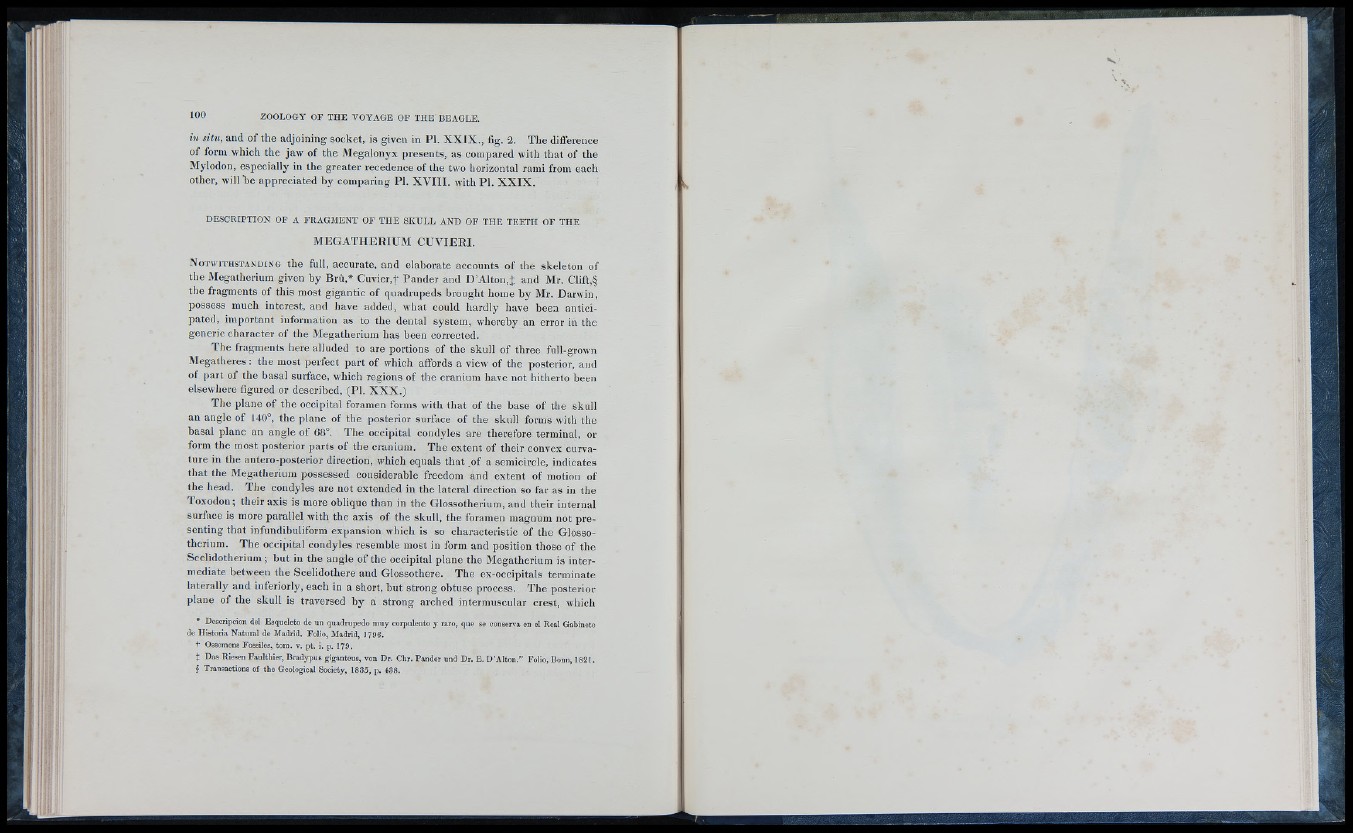
ill situ, and o f the adjoining socket, is given in PI. X X IX ., fig. 2. The difference
o f form which the jaw of the Megalonyx presents, as compared with that o f the
Mylodon, especially in the greater recedence o f the two horizontal rami from each
other, will he appreciated hy comparing PI. X V I I I . with PI. X X IX .
DESCRIPTION OF A FRAGMENT OF T IIE SKULL AND OF TH E TEETH OF TH E
M EG A TH ER IUM C U V IE R I.
N o tw ith s ta n d in g the full, accurate, and elaborate accounts o f the skeleton of
the Megatherium given b y Bru,* Cuvier,t Pander and D ’Alton,J and Mr. Clift,§
the fragments o f this most gigantic o f quadrupeds brought home hy Mr. Darwin,
po ssess much interest, and have added, what could hardly have been anticipated,
important information as to the dental system, whereby an error in the
generic character o f the Megatherium has been corrected.
The fragments here alluded to are portions o f the skull o f three full-grown
Megatheres : the most perfect part o f which affords a view' o f the posterior, and
o f part o f the basal surface, which regions o f the cranium have not hitherto been
elsewhere figured or described, (PI. X X X .)
The plane o f the occipital foramen forms with that o f the base o f the skull
an angle o f 140°, the plane o f the posterior surface o f the skull forms with the
basal plane an angle o f 6 8 °. The occipital condyles are therefore terminal, or
form the most posterior parts o f the cranium. The extent o f their convex curvature
in the antero-posterior direction, which equals that o f a semicircle, indicates
that the Megatherium p o ssessed considerable freedom and ex tent o f motion o f
the head. The condyles are not extended in the lateral direction so far as in the
Toxodon; their ax is is more oblique than in the Glossotherium, and their internal
surface is more parallel with the a x is o f the skull, the foramen magnum not presenting
that infundibuliform expansion w'hich is so characteristic o f the Glossotherium.
The occipital condyles resemble most in form and position those o f the
Scelidotherium; but in the angle o f the occipital plane the Megatherium is intermediate
between the Scelidothere and Glossothere. T he ex-occipitals terminate
laterally and inferiorly, each in a short, but strong obtuse process. The posterior
plane o f the skull is traversed by a strong arched intermuscular crest, which
Descnpcion del Esqiieleto de un quadrupedo muy corpulento y rare, que se conserva en el Real Gabineto
de Ilistoria Natural de Madrid. Folio, Madrid, 3 796.
+ Ossemens Fossiles, tom. v. pt. i. p. 179.
i Das Riesen Faulthier, Bradypus giganteus, von Dr. Chr. Pander und Dr. E. D ’Alton." Folio, Bonn, 1821.
§ Transactions of the Geological Society, 1835, p. 438.